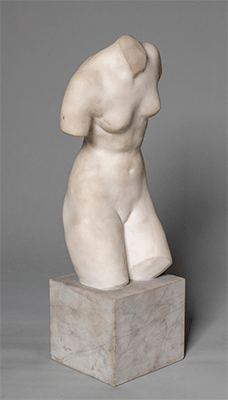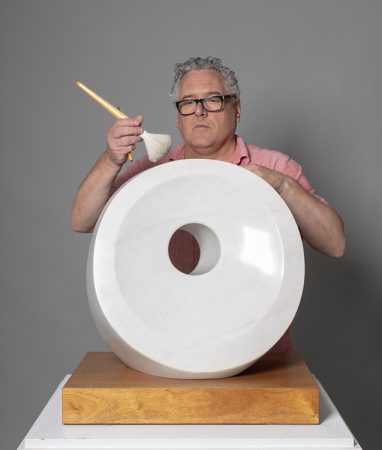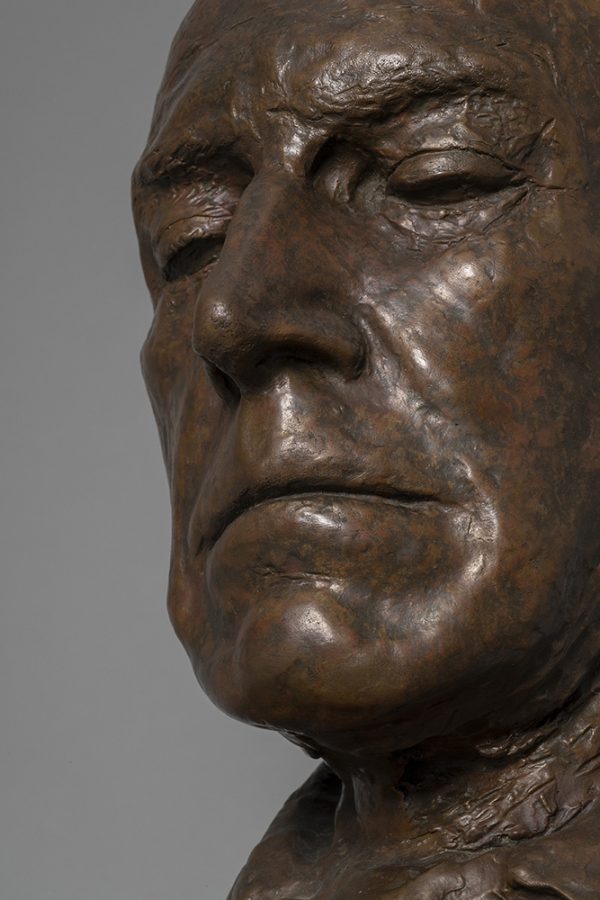Plymouth museum is closed at the moment for refurbishing and will open again as The Box in 2020. All of their collection of sculpture is being held offsite in an industrial estate on the edge of town, which is where I was to be based. The day started with fresh coffee, made by Lottie and an assortment of biscuits and cake at 8:30, and I was building the studio by 9am. This was hot work especially in the warm basement, I was feeling uncomfortable the pressure was on! Plymouth Museum were providing their own, hand built, extra-large table to photograph on, so my 2.7m width backdrop was deployed. The museum staff had been planning these two days for months and there was a big team of staff and volunteers to help me with the photographing. ArtUK had made it clear that photographers were not to be object handlers and Plymouth had many hands able to do this. My job was simply to photograph, although photography isn’t that simple is it?
 The lighting was a single Bowen’s head with softbox mounted on a boom arm stand. This had to be positioned with reflectors to light each sculpture evenly with a little definition through shadows but without those shadows losing any detail. The background always needed to look clean and without dark shadows. Photographs needed to be in focus and sharp and have enough depth of field so that the whole sculpture was in focus, with the background out of focus. The first photograph of any sculpture would include a QP card, so that white balance could remain constant through mine and through all the other photographers working on the project.
The lighting was a single Bowen’s head with softbox mounted on a boom arm stand. This had to be positioned with reflectors to light each sculpture evenly with a little definition through shadows but without those shadows losing any detail. The background always needed to look clean and without dark shadows. Photographs needed to be in focus and sharp and have enough depth of field so that the whole sculpture was in focus, with the background out of focus. The first photograph of any sculpture would include a QP card, so that white balance could remain constant through mine and through all the other photographers working on the project.
The front view, the first of six mandatory images, was often widely debated by the Museum staff, in particular the modern pieces. With a traditional sculpture e.g. the head and shoulders of a famous person, the front view is looking straight into the face. However, nonfigurative contemporary and modern work is often designed to be seen from all angles; so from which angle did the sculptor consider the front? The sequence of photographs always then took the same order, the second image taken with the sculpture moved 45° anticlockwise the third after it has been moved another 45° therefore giving the left-hand view of the object. The fourth photograph was the rear view then the right-hand side view the sixth and final view was 45° again or 45° clockwise from the front view. Once these images had been taken from a fixed camera point, same focal length and with similar lighting, a close-up, more creative, or abstract photograph could be taken. Time constraints might mean moving the sculpture around with the lighting static, and then taking the camera off the tripod to photograph the close-up. But sometimes the lighting would be made at a lower angle or less diffused to bring out the detail in a relief or an inscription.
The first day in Plymouth was spent photographing smaller sculpture. Because of their size they were light enough for raising up to and placing on the table and easy enough for a single object handler to move. I was able to keep up a good speed on making my photographs. Moving the sculptures around was straightforward and a single, close-up image, was generally made at the end of each shoot. One of the biggest photographic problems encountered on this day was getting the whole, or as much as possible of these sometimes, quite small sculptures, in focus. Adjustments were made with closing the lens aperture down and raising the iso to get a satisfactory image; I still haven’t worked out how high I can raise the iso for an image that would still be acceptable with my new camera. I was covering my bases, and all of those pictures looked great on my computer monitor later!
I was doing so well for time near the end of the day that a couple of sculptures were added to the schedule which weren’t on the original list.
-

-
Constellation – Barbara Hepworth
-

Day two was dedicated to the big and heavy sculptures, including this Barbara Hepworth marble. It was always going to take a lot longer to photograph these! The studio table was used initially but the effort it took to lift even smaller of these sculptures onto it was immense; and turning these heavy brutes around to their 6 positions tended to scratch and ruffle the background paper (of which I had already needed to cut off, and discard many metres of, in order to keep it clean). There were a few busts of famous people in this batch, often made of bronze, and rather than lift these onto the table they were photographed on the floor with background paper curved underneath them. Even moving these sculptures around was a backbreaking and tiresome job for the object handlers. Often these heavy sculptures were loaded onto a crate trolley, with a square of background paper beneath it, so that it could be moved around on wheels instead of having to physically lift it. Whilst I was engaged in this fashion, photographing large busts in the new floor-standing studio, the Museum staff were carefully unpacking a life size figure from a crate.
 There was a real excitement throughout the day as sculptures, often hidden away from public view, in wooden packing crates, were seen by museum staff for the very first time. It was also a time for staff to study the work at close quarters, noticing things that hadn’t come to light before; questioning some of the attributed names given to what presumably would have been ‘famous’ faces. One of their hopes through adding their sculpture collection to the huge ArtUK website/database, is that more information about the work might come to light. In fact for 25% of the sculpture that I photographed the artist’s name was not known. For example this life size bronze bust by an unknown artist was called ‘(portrait head, unknown sitter)’.
There was a real excitement throughout the day as sculptures, often hidden away from public view, in wooden packing crates, were seen by museum staff for the very first time. It was also a time for staff to study the work at close quarters, noticing things that hadn’t come to light before; questioning some of the attributed names given to what presumably would have been ‘famous’ faces. One of their hopes through adding their sculpture collection to the huge ArtUK website/database, is that more information about the work might come to light. In fact for 25% of the sculpture that I photographed the artist’s name was not known. For example this life size bronze bust by an unknown artist was called ‘(portrait head, unknown sitter)’.
Here are my photos of sculpture at The Box, Plymouth on the ArtUK website!
